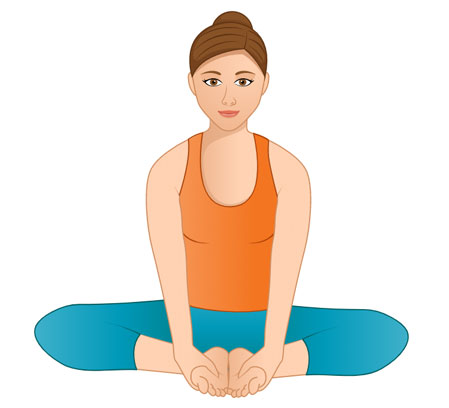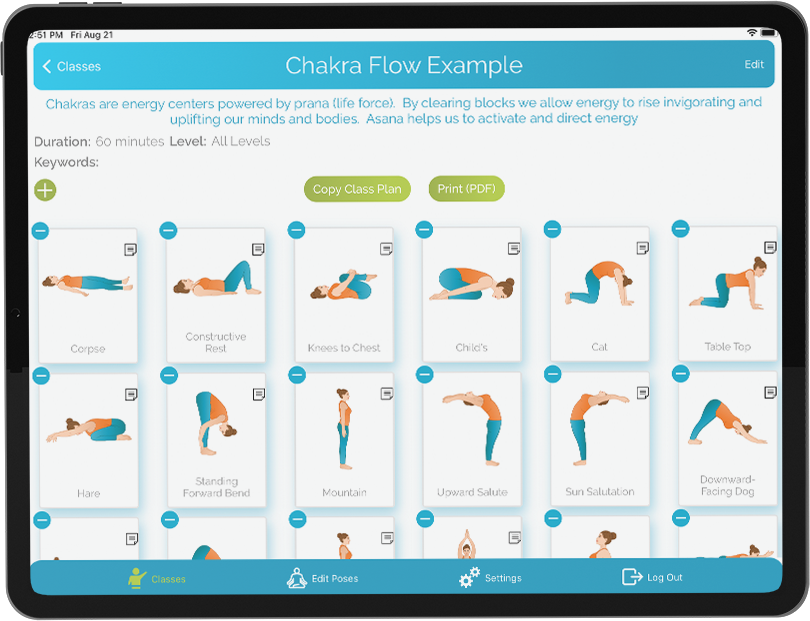Bound Angle Pose Baddha Konasana

STEPS
Seated, with the knees bent and the feet flat on the floor, slide the heels towards the pelvis. Bring the soles of the feet together allowing the knees to relax towards the ground. Hold the big toes with the middle and index finger, or conversely, place the palms on the ankles or shins. Keep the outside edge of the feet on the floor. To maintain alignment from the knee to the foot, avoid sickling the ankle joint. Lengthen the spine by drawing the hips, ribcage and shoulders into alignment. To deepen the posture, inhale to reach taller, and then exhale to fold forward from the hips.
TEACHER QUEUES
VISUALIZATION COMMENTS
Imagine the head of the femur (the upper thigh bone) relaxing down towards the floor, creating space between the hips and pelvis from which the spine can elongate. While folding forward, soften the breastbone and relax the head and neck. Use the breath to access the backspace of the body. Breathe into the lateral edge of the hips and up the spine. Use the exhale to release deeper
TECHNICAL COMMENTS
Yin vs. Yang Yin- the body can be soft in this pose, with the heels further away from the pelvis, allow the back to round and the shoulders and arms to relax. Try to let the musculature of the body soften. In this way the posture can be held anywhere from 5 to 15 minutes. Yang- to activate more strength in this posture, draw the heels in as close to the body as is comfortable. The elbows tuck into the sides of the body, shoulders back, hinge forward from the hips with a straight spine. The elbows can be used here to press the upper thighs towards the floor. Always avoid pushing on the knees!
BENEFIT COMMENTS
- Targets the hips and adductors. While folding forward, targets the spine.
- Helpful for menstrual cramps, infertility, anxiety and stress, menopause, heart disease.
- Stimulates the internal organs, including: spleen, liver, kidneys and gall bladder.
- Prepares the body for seated meditation
WATCH OUT FOR
- Students trying to force the knees down to the floor with their elbows or palms.
- Forcing the head towards the feet.
- Shoulders in the ears.
- Rolling the ankle joint (in some variations this posture is taught with the soles of the feet opening up to the ceiling like a book. This is not wrong, but may cause problems in the knee joint)
CONTRAINDICATIONS
High or low blood pressure.
Lower back or neck injury.
MODIFICATIONS
For stiff bodies, prop the hips with a cushion or block, allowing the pelvis to be neutral rather than in a posterior tilt. For pain in the knees, place a bolster underneath the knees or support each leg with cushions.
VARIATIONS
- Flatten the tops of the feet on to the floor, increasing the arch in the spine.
- Bring the legs closer together.
YOGA COUNTER POSES
- Bharadvaja’s Twist
- Cat
- Downward Facing Dog
- Standing Yoga Poses
Written By: Meghan Aris
Certified in several disciplines of yoga, a pilates teacher and teacher trainer, Meghan is continually widening her path of body/mind studies. At a young age she began her journey into body movement through dance. After being diagnosed with Rheumatoid Arthritis, she shifted her practice to more rehabilitative yoga. In this discipline she found not only the resources to heal her body, but also a guide to living a life full of peace and joy. She can be found teaching on any given day at The Space Vancouver.



